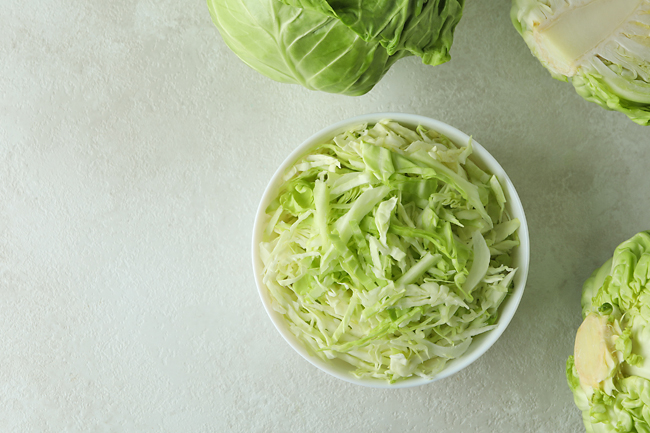Jim Webster
THE WASHINGTON POST – A few weeks ago, I wrote about a cabbage salad that I like to make, and it was fun reading the feedback to it. Most of the reaction was pretty positive, but human nature being what it is, I want to talk about one that was… less so. It wasn’t negative, really, but it was pointedly critical.
The email didn’t take issue with the recipe itself, but the writer said that they’d never make the salad because of something that they see in a lot of recipes. It called for a portion of a head of green cabbage and a portion of a head of red cabbage.
The point was succinct: What am I supposed to do with the rest of this cabbage?
Food waste is an issue that’s always at the front of my mind. I’ve written a lot about farmers, and I consider it a moral failing when I have to toss something that went bad on my watch. And food insecurity is a parallel issue that means a lot to me. So the email resonated.
But, honestly, that’s one of the reasons I like to always have some cabbage in my crisper. I’ve found that it has a pretty forgiving margin for error as far as its life span.
Before I get too deep into my personal practices, I poked around to look for an official guideline on how long cut vegetables are expected to last in the refrigerator. I didn’t really find one.



The FDA has a general rule that says leftovers can be safely kept for four days. When it gets into specifics, it doesn’t address fresh produce, but mostly meat, dairy and processed foods. Various sites I found suggested that cut cabbage can be stored anywhere from two days to several weeks. Which didn’t feel like an answer, either.
Whole cabbage is a cold storage crop, meaning that any head you buy at the grocery store was probably harvested weeks, if not months, earlier. How fast is it likely to deteriorate once it gets cut?
I talked to Washington Post contributor on food safety issues Rachael Jackson, who said she was unaware of any official guidelines. She said that once you cut into any vegetable, it becomes more susceptible to spoilage, and that any number of variables (moisture levels, temperature, how it was cut) can influence the speed at which that happens.
So where does that leave us?
Here’s my strategy: When you bring home a fresh cabbage, use it for any raw preparations first. Wrap it and keep it in the fridge, and if you want to use it raw again, do it within the next few days.
After that, use it only in cooked applications to kill anything problematic that might have grown in the interim. (Experts said leftovers should reach a temperature of 165 degrees or come to a rolling boil).
If you find that it is slimy, smelly or soggy – in other words, in any way unappetising – pitch it (or, ideally, compost it).
When I got that reader email, I had already been thinking of a dish of tomato gravy over grits, and was contemplating ways to make it more substantial without the meat fat that would traditionally be the base.
That’s when I saw the leftover cabbage in my crisper and realised I could solve two problems at once by smothering the cabbage in a tomato gravy flavored with a tablespoon of smoked paprika.
Then I added cabbage to my shopping list, because I was out.
CHARRED CABBAGE SMOTHERED IN TOMATO GRAVY OVER GRITS
Feel free to add more cabbage to smother in the gravy; the recipe will accommodate as much as double without increasing the amount of tomato. It’s a great way to use up extra cabbage and extend the dish to more servings.
INGREDIENTS
– Four cups water
– One cup grits (not quick-cooking or instant)
– One teaspoon fine salt, divided
– One tablespoon olive oil
– One pound green cabbage (1/2 medium head), thinly sliced
– Two tablespoons apple cider vinegar
– One small red or yellow onion (four ounces), thinly sliced
– Three cloves garlic
– One (28-ounce) can crushed tomatoes
– Two tablespoons tomato paste
– One tablespoon smoked paprika
– One cup no-salt-added vegetable broth, store-bought or homemade
– Two tablespoons unsalted butter, dairy or vegan
– Freshly ground black pepper
DIRECTIONS
In a medium pot over high heat, bring the water to a boil. Slowly add the grits, then half teaspoon of the salt, and stir. Let the water return to a boil, then reduce the heat to medium-low. Partially cover and cook, stirring frequently and scraping the bottom of the pot to prevent sticking, until thick and tender, 25 to 30 minutes.
Meanwhile, in a large skillet over medium-high heat, heat the oil until it shimmers and just starts to smoke. Add the cabbage, arrange it in an even layer and cook without moving it until it begins to char, two to three minutes.
Stir and let more of the cabbage char, another two to three minutes. There should be blackened spots. Add the vinegar and toss to coat. Transfer about one cup of the cabbage to a plate and reserve. Push the rest of the cabbage to one side of the pan.
Add the onion and cook, stirring, until softened, about three minutes. Stir in the garlic, and cook until aromatic, about one minute. Add the crushed tomatoes, tomato paste, paprika, broth and the remaining half teaspoon salt, and stir to combine. Bring to a boil, then reduce the heat so the mixture is at a simmer and cook until chunky and soupy, 15 to 20 minutes.
Stir in the butter to incorporate.
Divide the grits among wide, shallow bowls, forming a well in the middle. Fill each well with the tomato gravy, then top each portion with some of the reserved cabbage. Season with pepper and serve hot.







